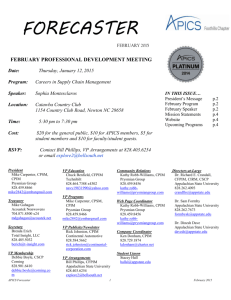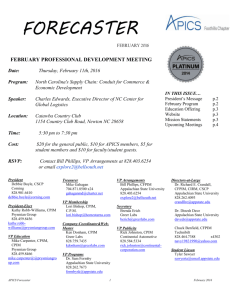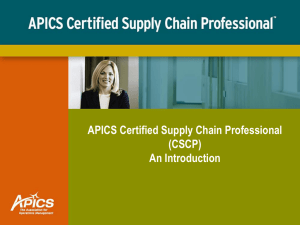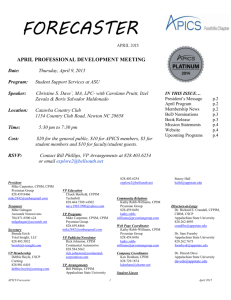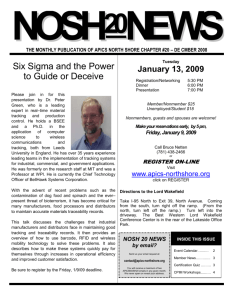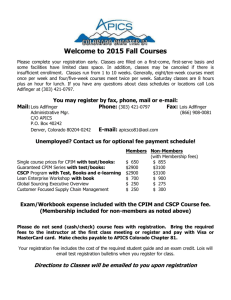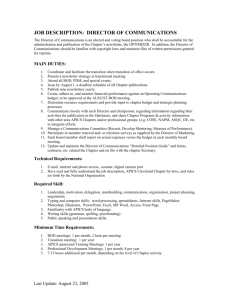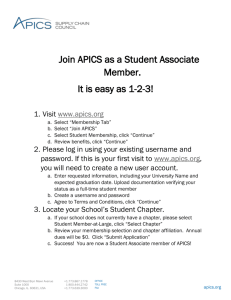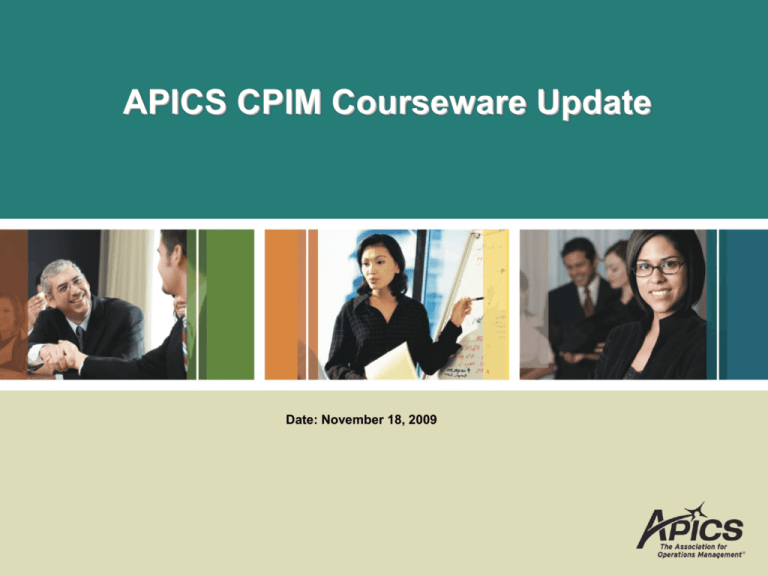
APICS CPIM Courseware Update
Date: November 18, 2009
CPIM Courseware Update
Jerry Kilty, CFPIM, CIRM, CSCP
Quality Management Solutions, Inc.
CPIM Courseware Update Plan
• Three-year plan
– 2008: Rewrite BSCM
– 2009: Rewrite DSP and SMR
– 2010: Rewrite MPR and ECO
– 2008, 2009, and 2010: Update all courseware to be
consistent with the latest exam content manual (ECM)
Today’s Agenda
•
•
•
•
•
•
Instructional design changes
Content changes in the new DSP
Content changes in the new SMR
Updates to MPR, ECO and BSCM
Preparing to teach
Summary
Instructional Design of New DSP
and SMR Courses
Learning Objectives
From:
Objectives of Session 5
Understand global sourcing and distribution
and other international issues of managing
the supply chain
Explain the strategic relationship among
alliance members of the supply chain
Recognize how the choices and
development of information technology
affect the supply chain
Specific, measurable
objectives to guide
instructor and students
5-3
Strategic Management of Resources, Version 1.4 – January 2009
© 2009 APICS CONFIDENTIAL AND PROPRIETARY
To:
Learning Objectives
Supply Chain Management
Learning Objectives (cont.)
– Describe the relationship between the supply network and an
organization’s supply chain.
Managing Supply Chain Relationships
– Explain that supply networks consist of the flow of quality, speed,
– Differentiate between arm’s-length and long-term partnerships.
dependability, flexibility, and cost among operations.
– Explain the objective of disintermediation.
– Explain the role of supply chain management in managing flows
– Describe the advantages of outsourcing.
among operations owned by different organizations.
– Describe the advantages of vertical integration.
Capacity Planning
– Explain the benefits of supplier reduction.
– Explain the advantages and disadvantages of large- and small– Explain the improvements companies can make to reduce the
scale facilities.
bullwhip effect.
– Describe the impact of scale of operations on capacity planning.
– Differentiate between lead and lag capacity strategies.
53
© 2010 APICS CONFIDENTIAL AND PROPRIETARY
54
© 2010 APICS CONFIDENTIAL AND PROPRIETARY
Example IG Page and
Transition Slide
• Transition slide header in IG
corresponds to new transition slides
• Smaller slide graphics
• More instructor guidance
• References given
• One-column format
• New icons
Example PW Pages
Updated and improved content
Problems and Solutions
Problem Icon
Solution Icon
Build Slide Icon
Problem 1.2 Solution
Date
Quantity
Received
Unit
Cost
($)
March
─
10
0
─
14
0
April
100
10
1,000
70
14
980
May
100
12
1,200
30
14
420
40
12
480
60
12
720
10
10
100
June
July
100
─
14
16
Inventory Usage Issue Unit Issue Value
Value ($) Quantity Cost ($)
($)
1,400
─
─
Cost of goods sold = $2,700
July starting inventory of 90 at $10
$900
Vocabulary Check
• ECM Key terminology
• Reinforces dictionary definitions
• Matching or crossword
Performance Check Answers
“Wiki” Activity
• Second half of last session
• Students work collaboratively to build a knowledge base
on several topics (similar to “Wikipedia” approach)
• Students then write mock exam questions
• Students take the mock exam
• Added as appendix to MPR, ECO, DSP, and SMR
Content Changes To DSP
And SMR
New DSP and SMR Courses
• Why the Change?
– Update content to meet new 2010 ECM
requirements
– Improve the narrative
– Improve participant content and instructor guidance
– Include more interactions and activities
– Reinforce key terminology
– Make a visual impact
– Improve the experience for the instructor and
students
DSP Course Roadmap
Session:
1. Inventory policies
2. Inventory planning
3. Information used in the
material planning process
4. MRP mechanics: the
basics
5. Using MRP outputs and
managing projects
6. Detailed capacity planning
7. Detailed capacity
management
8. Establishing supplier
relationships
9. Supplier partnerships and
review activity
Key Content Changes - DSP
• New and improved performance check questions
• Changed the MRP Mechanics section to be more
interactive
• Expanded material planning content in project, flow
and lean environments
• Updated the procurement section to support suppliercustomer collaboration and logistics approaches to
accelerating the supply chain
Key Content Changes - DSP (cont.)
• Added ECM emphasis on:
– Service industry content
– Project management
– Role of lean/JIT
• in resolving sales and operations planning
conflicts
• on improving throughput and reducing inventory,
and the financial implications thereof
• Improved the process flow scheduling and line
balancing content
Reference Changes—DSP
APICS CPIM DSP reprints were updated from
2001 to 2010
SMR Course Roadmap
Strategic Management of Resources
1.
3.
4.
Developing the
Business
Strategy
The Global
Environment
and
Sustainability
Operations
Strategy
Operations
Strategy Choices
and Financial
Measurement
Aligning
Operations with
Supply Chain
Partners
Infrastructure
Systems
Change
Management
Case Studies
and Review
Activity
5.
13
2.
6.
7.
© 2010 APICS CONFIDENTIAL AND PROPRIETARY
8.
Session:
1. Developing the Business
Strategy
2. The Global Environment
and Sustainability
3. Operations Strategy
4. Operations Strategy
Choices and Financial
Measures
5. Aligning Operations with
Supply Chain Partners
6. Infrastructure Systems
7. Change Management
8. Case Studies and Review
Activity
Key Content Changes - SMR
• Increased emphasis or expanded coverage of
– Business strategy development (competitive forces,
SWOT analysis)
– Role of operations strategy and performance
objectives in supporting the business strategy
– Supply chain management strategies
– Financial analysis/measurement of operations
Key Content Changes - SMR
• New content in the following areas:
– Supply network design and ownership issues
– Expansion into foreign markets and globalization
– Sustainability and corporate social responsibility
– Risk assessment and mitigation
Key Content Changes - SMR
• Case studies:
– Encourage “higher-level thinking”
– Format: Short scenario descriptions followed
by probing multiple choice questions
– Cover both service and manufacturing firms
– Instructor guide explains the answers
Key Content Changes - SMR
• Six case studies covering seven topics:
– Alignment of competitive and operations strategies
– Operations strategy and performance objectives
– Quality and operations management choices
– Global competitive and operations strategy choices
– Scale, capacity, and layout effects on operations
– Quality systems and risk management/recovery
– Differentiation between order winners and qualifiers
Reference Changes - SMR
• All prior references have been replaced by new content
from selected textbook chapters and journal articles into
a sourcebook
• The sourcebook is: APICS Strategic Management of
Resources References Sourcebook, Pearson Custom
Publishing, 2009.
• An exception is the 12th edition of the APICS Dictionary,
which is not included in the sourcebook.
Reference Changes - SMR
• Textbooks:
– Slack et al., Operations and Process Management, 2nd ed.,
FTPrentice Hall, 2009
– Thompson et al., Crafting & Executing Strategy, 15th ed.,
McGraw-Hill Irwin, 2007
– Horngren et al.,, Financial and Managerial Accounting, 2nd ed.,
Prentice Hall, 2008.
– Jacobs et al., Operations and Supply Management, 2nd ed.,
McGraw-Hill Irwin, 2009.
Reference Changes - SMR
• Harvard Business Review Reprints:
– Strategy and Society: The Link Between Competitive
Advantage and Corporate Social Responsibility
– The Contradictions that Drive Toyota’s Success
– The Secrets to Successful Strategy Execution
– Leading Change: Why Transformation Efforts Fail
• Other Articles:
– EMS and Sustainable Development: A Model and
Comparative Studies of Integration
– Current Operational Practices of U.S. Small & Medium-Sized
Enterprises in Europe
– Lean Accounting and Finance
Changes to MPR,
ECO, and BSCM
2010 ECM Reference Changes
BSCM:
– BSCM reprints updated from 2006 to 2009
ECO:
– Added: Intro. to Materials Management, Arnold et al.
– Removed: Capacity Management by Blackstone
– Removed: Managerial Accounting by Garrison et al.
MPR:
– MPR reprints updated from 2007 to 2010
BSCM, ECO, MPR Changes
Course
Edits from
Instructor Log
Edits from ECM
Changes
Additional Information
BSCM
86
4
59 slides updated, 142 pages
changed
ECO
2
2
One new page on supplier
and customer service
measures; 12 pages changed
MPR
14
5
Nine slides updated, four new
slides, two new pages, 24
pages changed. Updates
include
•Logistics resource planning
•CPFR
•Transportation performance
characteristics
Recommendations for
Preparing to Teach
• For DSP and SMR
• Order replacement instructor kits: $150 price is good
through March 31, 2010.
• BSCM
• Order $25 update kit—price good through July 1, 2010.
• Pre-orders taken as of November 16, 2009
• Official release for all materials is December 14, 2009
Recommendations for
Preparing to Teach (cont.)
• MPR and ECO
• Download net change documents and replacement
pages at www.apics.org/InstructorCenter/CPIM/
• Downloads available December 14, 2009
• Or order $25 update kits
• All courses
• Review new 2010 ECM and references
Summary
Summary
• Extensive analysis led to 3-year update plan
• Course rewrites include a new format and improved
instructional design.
• Extensive content changes and updates were made
to DSP and SMR.
• All course content was update to correspond to the
2010 ECM.
• We gave recommendations for preparing to teach the
courses.
Acknowledgements
• DSP
– Richard Donahoue, CPIM, CSCP (Lead)
– Tom Cox, CFPIM, CSCP
– Susan Franks, CPIM, CSCP
– Tom Geraghty, CPIM
– Debra Hansford, CPIM, CIRM, CSCP, CPM, CPSM
– Ed Kantor, CPIM
– Carolyn Farr Sly, CSCP, CPIM, CPM
Acknowledgements
• SMR
– Chuck Nemer, CPI, MA-Leadership (Lead)
– Pam Somers, CPIM CIRM CSCP
– Michael Ford, CFPIM, CSCP
– Tom Geraghty, CPIM
– Richard Donahoue, CPIM, CSCP
– Tom Cox, CFPIM, CSCP
Acknowledgements
• MPR
– Michael D. Ford, CFPIM, CSCP (Lead)
– Howard Forman
• ECO
– Thomas Cox, CPIM, CSCP
– Ed Kantor, CPIM
– Rob van Stratum, CPIM CIRM, CSCP
• BSCM
– Thomas Geraghty, CPIM (Lead)
Thank you for attending this
APICS Webinar.
Be sure to visit the APICS Web site for information about
upcoming and archived presentations.
This APICS Webinar is the property of APICS,
and is protected by the United States and international
copyright laws. All rights are reserved.
Questions regarding this webinar can be emailed to
pdadmin@apics.org. Answers will be posted to the CPIM web
page within the Instructor Center. (Tawana)
To replay this webinar, visit the CPIM web page within the
Instructor Center.

